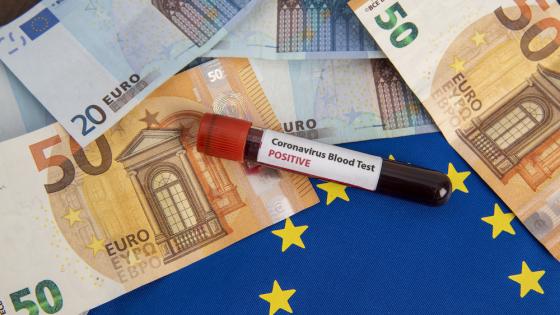The COVID-19 pandemic has massive detrimental economic effects and demands immediate policy actions to prevent a financial or debt crisis (e.g. Baldwin and Weder di Mauro 2020). In this column on the implications of the coronavirus for financial stability in Europe, we address how to mitigate a systemic financial crisis that is propagating in slow motion, as we speak, and which we identified and diagnosed in SAFE policy letter 78 (Boot et al. 2020). This column emphasises the speed at which the underlying unprecedented real sector cash drains and how asymmetric national solutions may be destabilising in the longer run.
Our main conclusion: A coordinated fiscal plan at the pan-European level, complementing national measures, is crucial for financial stability in Europe. The plan has to be substantial in size, implemented immediately, and backed by a common fiscal backstop. While today’s policy actions inevitably have to be undertaken at a quickened pace, it is paramount to also account for the longer-term implications of the chosen policies and instruments for a post-crisis Europe now. We see two weaknesses of the current fiscal policy responses in Europe:
- their design and implementation are happening in an uncoordinated manner, at the national level, and
- they rely almost exclusively on debt instruments.
While the current solutions have some merit in the short term, they put financial stability in the longer run at risk.
We argue that the current national fiscal policies, despite their boldness in scope and scale, especially in Germany and the Netherlands, with ‘unlimited volume’, may turn out to have counterproductive side effects for Europe as a whole in the future. Doubtless, these measures are now essential to provide much-needed liquidity to firms and banks, but, given their supra-national nature, they ought to be supplemented immediately by a broad, coordinated fiscal plan at the pan-European level, to provide immediate support and a safety net for the weaker countries, already threatened by market reactions to the announced policy interventions. Ultimately, of course, they also benefit the stronger links in this interdependent chain.
ECB monetary policy alone cannot deal with the economic divergence in the Eurozone; longer run negative side effects should be considered as of today. Thus, while we applaud the ECB’s extraordinary €750 billion asset purchase programme (the Pandemic Emergency Purchase Program, or PEPP), we fear that without a complementary European fiscal plan, commensurate in ambition, this substantial monetary intervention alone would have limited impact. It may even turn out to have counterproductive implications in the longer run, with severe consequences for the common European mission.
The (updated) issue: Coronavirus and the first line of economic defensive measures
As diagnosed in our earlier policy letter, the economic challenge the world – and Europe in particular – is facing now is an extended interruption of the activity of otherwise (mostly) solvent businesses. An interruption of economic activity considerably exceeding three months seems likely today.1 Using recent statistics on infections, the number of business shutdowns, and public curfews in Europe’s economies, we are facing the possibility of an almost complete economic shutdown, or at least a very significant ‘output gap’ for a large part of the year. Even if the formal shutdown would be of a shorter duration, the complexity of the global production chains coupled with the apparent lack of coordination across countries will likely complicate the eventual return of the global economy to normal business, and thus inescapably extend the duration of business closure.
On Monday this week, the Eurogroup issued a “Statement on Covid-19 Economic Policy Response,” emphasizing an EU-level €37 billion investment initiative, an €8 billion working capital lending scheme for 100,000 firms and a €10 billion investment fund for small and medium-sized enterprises (SMEs). Coupled with the various national emergency assistance schemes, the non-financial or real sector is, thus far, supposed to receive funds from national authorities mostly in the form of bridge financing via debt instruments, as well as public subsidies for unemployed or underemployed workers in the most-affected industries.2 However, all of these measures are taken in view of national perspectives only.
According to the Eurogroup statement on 16 March (European Council 2020), fiscal measures will be put in place amounting to roughly 1% of GDP, with an additional 10% of Europe-wide GDP made available for automatic stabilisers, such as Kurzarbeit (the German model to combat unemployment), and access to liquidity facilities via public guarantees and tax deferrals. While these measures are welcome and necessary to contain some of the immediate fallout, a longer duration of the crisis, extending beyond three months, would further require timely, coordinated pan-euro area measures on a much larger scale, and wider in scope.
The recent ECB €750+ billion asset purchase programme goes in the right direction. A particularly welcome feature is that the programme has no predefined limit. It can be scaled up “by as much as necessary and for as long as needed”. In any case, it will not end before 2020. It is worth pointing out that purchases will also include Greek securities for the first time. To prevent a further surge in sovereign bond yield spreads between the member states, the ECB is willing to deviate from the capital key in the future. With regard to the private sector, the ECB will expand the scope of its Corporate Sector Purchase Programme (CSPP) to include all commercial paper of sufficient credit quality. Finally, collateral standards will be relaxed. By themselves, while welcome, these measures will not suffice to fight the core of the problem. We need a strong European coordinated fiscal policy intervention that, at least so far, is absent.
The preponderance of national fiscal policies to combat the coronavirus crisis in Europe has already led to programmes that differ significantly across countries – in terms of size, in euros per capita, or euros per firm/employee. Some Northern European countries, like Germany and the Netherlands, can offer nearly unlimited amounts of assistance, for example in the form of labour cost support and loan guarantees, whereas the fiscal measures taken by Italy, for instance, appear to be quite limited in size, obviously encumbered by their fiscal constraints. As an unintended consequence that will become more visible during a post-crisis recovery, this disparity in responses will also shift the growth prospects across countries in a manner analogous to what was experienced during the euro area sovereign crisis, i.e. the strongest economies will get even stronger, and the weaker ones even more fragile. This looming, increasing divergence across EU (and EMU) member states potentially undermines the whole European project.
Thus, in a longer-term perspective, the asymmetric fiscal response at the national level threatens Europe’s financial stability and, ultimately, its future. Indeed, given their disparate sizes, the emergency programmes would likely accentuate the competitive strength of the more-assisted against the less-assisted firms, which would reinforce divergence among euro member countries.
We can only speculate about the longer-term consequences of such divergence, and fear that peripheral countries will lose out if the current dispensation were to continue. However, such an outcome would ultimately be costly for the core countries as well, even if we disregard the political costs of an unequal treatment of firms across nations in Europe. The national policies of today lead to over-indebtedness of the peripheral economies and potentially overwhelming their financial systems, as an almost necessary upshot endangering sovereign solvency. This, in turn, may lead to a systemic crisis in the banking sector, affecting the whole of Europe through contagion, as almost happened during the sovereign crisis in 2011, with Troika interventions that no one would wish to see again.
Further, the nature of support needs rethinking. Corporate and bank defaults are highly likely and inevitable in the wake of this rapidly evolving crisis. Measures to address the problems, however, typically rely on the provision of liquidity in the form of debt facilities, mostly via the banking system. While understandable in terms of their expediency, debt guarantees provide for funding stability, but are not the most effective instrument for risk sharing. Therefore, where feasible, guarantees on debt facilities should be complemented and buttressed with equity-type risk sharing instruments. Moreover, these instruments need credibility, which requires credible pan-European backing.
This brings us to the main question faced by Europe in the wake of the coronavirus pandemic: How to design an emergency assistance scheme that (i) effectively supports businesses, (ii) provides incentive-compatible risk sharing, and (iii) prevents further divergence among euro member states.
Recommendations: Temporary supplements to the European financial architecture
Our basic proposal is twofold:
- the assistance programmes need pan-European backing, and business support arrangements need coordination across Europe;
- there should be a shift towards risk sharing instruments in supporting businesses.
Thus, risk sharing should be interpreted as a tilt away from debt instruments towards equity-like instruments, as well as a common, European backing of such arrangements.
First, to contain the destabilising effects of unequal access to fiscal support for firms across the European countries, in view of the differences in fiscal capacity at the national levels, the assistance programmes that provide funding to the larger firms in response to the emerging output gap should be designed and monitored by an EU institution (the ESM or the EU COM). These programmes can be implemented in a two-tier model, relying on national institutions for execution. At the European level, this would help create greater balance in the design and implementation of the assistance schemes for such firms, reducing divergence between member states.
Second, in order to reduce the debt dependence of businesses, we propose that future fiscal action ought to strengthen the ‘skin-in-the-game’ financing, wherever this is possible. For example, the planned emergency funding for firms could systematically build on equity-like arrangements such that firms become less indebted, which adds to their risk absorbing capacity, and leave potential upside for the public sector financier in the successful recovery that we hope will follow. Consequently, firms will not be overloaded with new debt when the crisis is over, and insolvency risk is reduced down the line. The downside risk associated with the economic consequences of the pandemic is then borne by the issuer of the instrument, i.e. at the pan-Eurozone level.3
Our proposed structure would ensure that the potential drastic financial consequences of the pandemic would permit the sharing of risks and rewards in a major rescue scheme at the euro area level, similar to the Troubled Asset Relief Program (TARP) used in the US after the global financial crisis.
Conclusion
Our message is an urgent plea for a common European policy response to the global coronavirus pandemic. National solutions alone with nearly unlimited amounts of assistance in some core countries and strict limits elsewhere are destabilising. They risk worsening an already stressed European situation through inescapable side effects.
Also, the nature of support needs rethinking. The massive provision of liquidity in the form of debt facilities is understandable, but ultimately many recipient firms will be over indebted, thus some equity-type risk sharing instruments are needed. Moreover, these instruments need credibility, which requires credible pan-European backing. Time is of the essence with a massive infusion of risk capital at the firm level, and possibly at the bank level. Once this crisis passes, as it will with sustained efforts, we will share the returns to these investments Europe-wide, since risk sharing and reward sharing are going hand in hand. These efforts will prepare working towards a better and stronger Europe.
Authors’ note: This column was first published as SAFE Policy Letter No. 79. SAFE policy letters represent the authors‘ personal opinions and do not necessarily reflect the views of the Leibniz Institute for Financial Research SAFE or its staff. We want to thank Johannes Kasinger and the SAFE Policy Center Team for their excellent guidance through the discussion and writing process.
References
Baldwin, R, and Weder di Mauro, B (eds) (2020), Mitigating the COVID economic crisis: Act fast and do whatever it takes, a VoxEU.org eBook, CEPR Press.
Boot, A, E Carletti, R Haselmann, H-H Kotz, J P Krahnen, L Pelizzon, S Schaefer and M Subrahmanyam (2020), “The Coronavirus and Financial Stability”, SAFE Policy Letter 78.
German Federal Ministry for Economic Affairs (2020), “A protective shield for employees and companies”, 13 March.
Government of the Netherlands (2020), “Coronavirus: kabinet neemt pakket nieuwe maatregelen voor banen en economie”, 17 March.
European Council (2020), “Statement on COVID-19 economic policy response”, 16 March.
Endnotes
1 A more precise interruption estimate could be based on work done by professional epidemiologists, such as the World Health Organization/Imperial College Models.
2 E.g., for Germany: German Federal Ministry of Economic Affairs (2020); for the extensive Dutch measures, see Government of the Netherlands (2020)
3 We will devote a future SAFE Policy Letter to the further details on risk sharing policies and instruments during the pandemic crisis. This will discuss pan-European pandemic crisis investment funds financed by the participating states, using a common key, and possibly leveraged by institutional and private investors.








